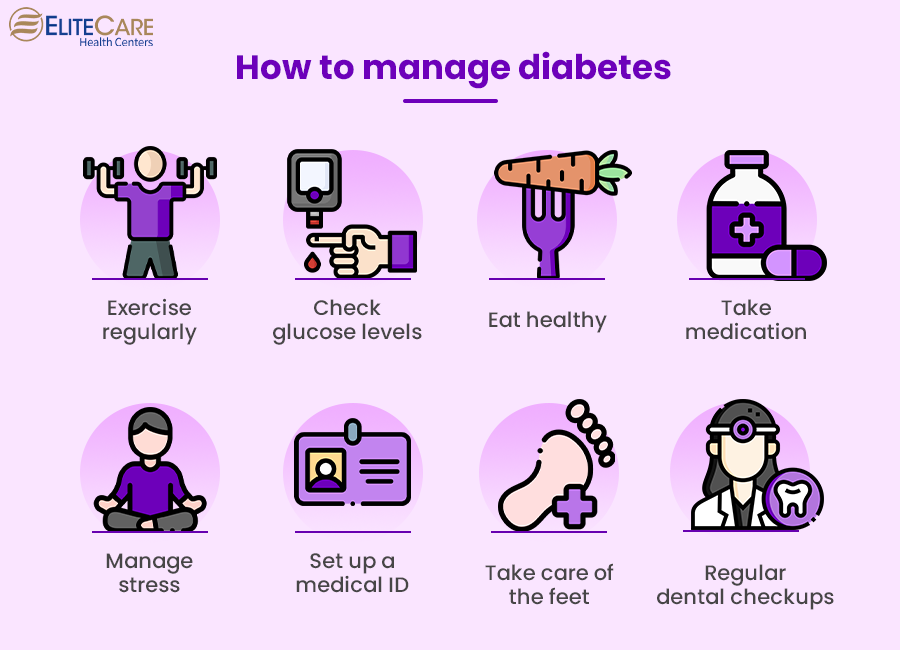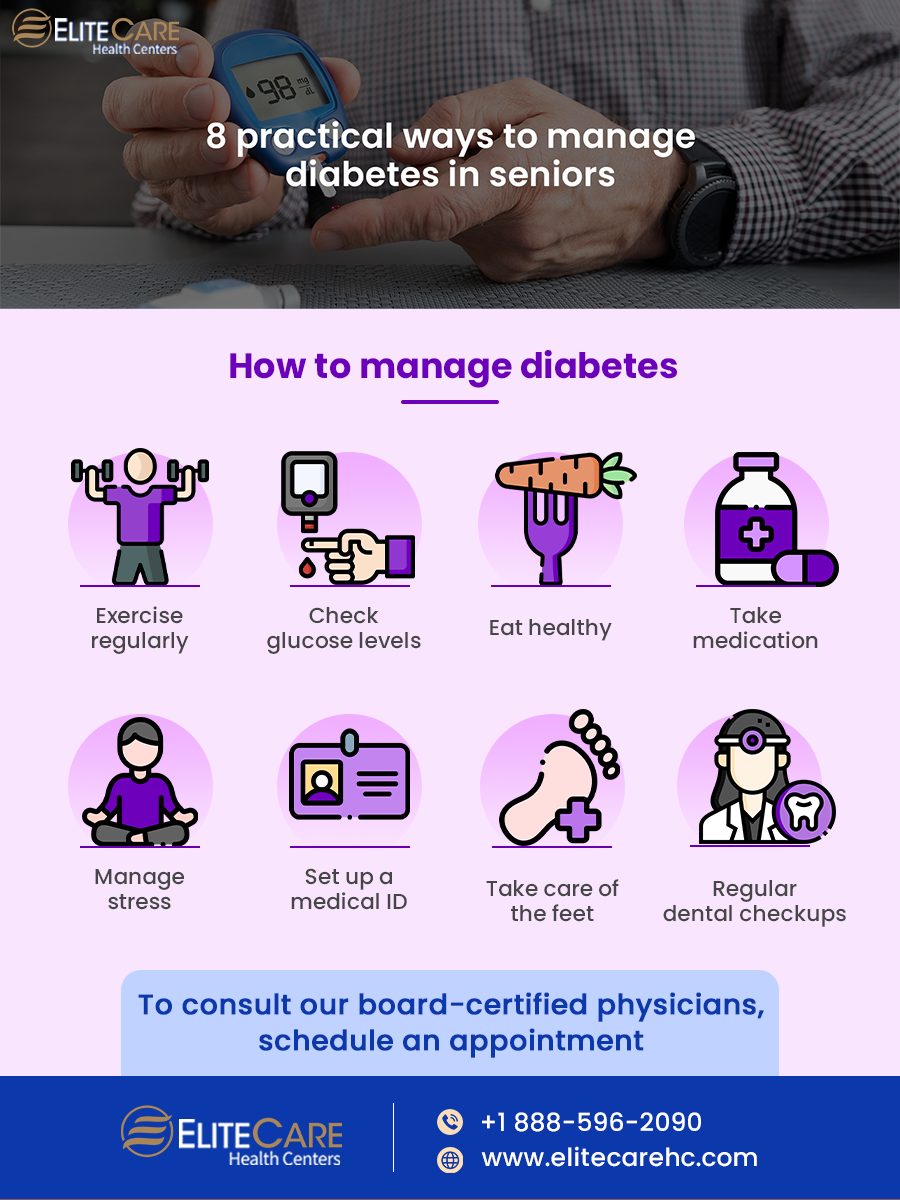
How to manage diabetes in seniors
By maintaining sufficient blood glucose levels and making healthy lifestyle changes, diabetes in seniors can be easily dealt with. Below are some practical methods that you can follow to manage diabetes and ensure a healthy, long life:

1. Exercise
Exercise is key to maintaining blood glucose levels for seniors and aids in healthy weight loss. Aerobic exercises such as walking, swimming, and bicycling can also help control glucose levels in seniors.
It is crucial to know that it can be difficult to exercise when one’s blood sugar level is low. Hence, it is generally recommended to schedule exercise an hour or so after a meal – when blood sugar levels are generally higher. As a caregiver, you should always carry glucose tablets, water, and carbohydrate-rich snacks to manage diabetes in seniors more efficiently.
2. Check glucose levels regularly
Diabetes in seniors can make them more susceptible to hypoglycemia (low blood sugar). Therefore, while taking medication for diabetes, it is particularly important to monitor glucose levels regularly. Symptoms of hypoglycemia include confusion, dizziness, sweating, and hunger.
Your healthcare provider will let you know how and when to check your blood sugar levels. Generally, those taking insulin or having a particularly hard time controlling blood glucose levels, or suffering from hypoglycemia (low blood sugar), need to monitor their blood glucose levels regularly. For a quick fix, you can have some glucose tablets or drink some fruit juice as advised by your provider.
Read More: Foods That Help Lower Blood Pressure
3. Maintaining a healthy diet
It is essential to consume a healthy diet that is low in sugar (including sugar from fruits) and saturated fats to keep diabetes in seniors under control. In order to maintain optimal glucose levels, you might want to develop a meal plan with the help of a registered dietitian or by yourself – if you’re knowledgeable about the subject.
You and your caregiver can even coordinate and prepare a diet plan together to help each other eat better.
Read More: Can Certain Food Improve Your Brain Health?
4. Never miss taking your medication
You may often forget to take your diabetes medication while being caught up in everyday life. To help you take medication every day without forgetting, you can use a medicine organization tool (such as a pill box) and make use of an alarm on your phone or computer to remind yourself when to take your medication.
You can also keep a checklist to check off items when you take your medicine each day. It’s important to maintain consistency and punctuality in taking the prescribed dose of medicines every day to manage diabetes in seniors.
5. Practice stress relief techniques
An increase in stress levels can worsen diabetes in seniors as the fight-or-flight response triggered by stress can increase blood sugar levels. Hence, it becomes crucial for diabetic seniors to practice stress relief techniques.
You or your caregiver can get you to practice techniques like yoga (at your convenient pace), and meditation to calm your mind. Also, get a massage or develop a new hobby that can be your creative outlet to relieve stress.
6. Set up a medical ID
Diabetes in seniors can pose a risk of medical emergencies caused by issues such as fluctuating blood sugar levels or a severe infection from a wound. Therefore, it is extremely important for a diabetic to have some sort of medical ID just in case of a medical emergency.
This means having the diabetic senior wear a Medical Alert ID bracelet or necklace. Alternatively, they can also enter Medical ID information into the emergency section of the smartphone they regularly carry.
7. Regular visits to the dentist
Diabetes in seniors can spike the amount of glucose in their saliva which can give rise to a mix of harmful bacteria that combine with food to form plaque. Therefore, it can lead to problems like cavities and tartar. If not treated, these problems can lead to the loss of teeth. Almost 25% of U.S. adults with diabetes aged 50 and older have severe tooth loss, compared to about 16% of patients without diabetes. Therefore, it’s crucial to visit the dentist regularly to prevent these problems.
8. Regular visits to the dentist
Diabetes in seniors can result in foot disease. Hence, make sure to check your feet, keep them clean, and have your caregiver check them for cuts, wounds, or signs of infection. Proper foot hygiene needs to be maintained. Make sure no infected nail tools or pedicure instruments are used as they can result in near-fatal infections. Always wash your feet and use moisturizing lotion to prevent dryness and avoid blisters.
Read More: 7 Habits of Healthy Living
Conclusion
Diabetes in seniors can be challenging but luckily it is manageable with care and consistency while maintaining a healthy lifestyle. If you’re looking for effective care related to diabetes in seniors from the best primary doctors in Florida, please know that we have some of the best geriatric primary care physicians working on our team. Get personalized care from trained professionals at our center near you. Call +1 888-596-209 to schedule an appointment.
- Tags:diabetes in seniorsdiabetes risk factorsglucose levels for seniorshealth and wellness centerhealth and wellness serviceshealth care centerknee pain treatmentmedical cliniconline doctor consultationpreventive careprimary careprimary care center near meprimary care physicianprimary care servicesprimary servicessenior care services






